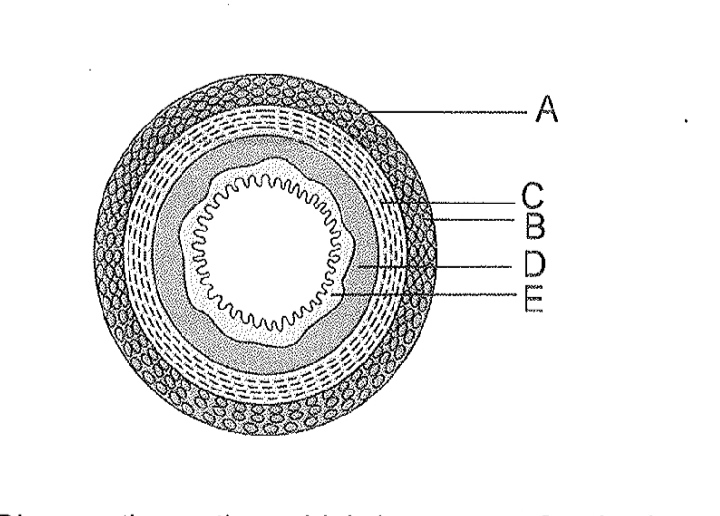Which type of cells are the part of tubular glands
of the stomach epithelium?
A. Pariental cells
B. Peptic cells
C. Zymogen cells
D. Oxyntic cells
(1) D only
(2) A & d
(3) A, B & c
(4) A, B, C & D
Digestion of fats starts in
(1) Mouth
(2) Stomach
(3) Small intestine
(4) Pharynx
Given below is a diagrammatic representation of
transverse section of gut

Choose the option which is correct for the layers
labelled as A , B, C, and E
(1) A Serosa
B Longitudinal muscle layer
C Circular muscle layer
D Mucosa
E Submucosa
(2) A Mucosa
B Circular muscle layer
C Longitudinal muscle layer
D Submucosa
E Serosa
(3) A Serosa
B Circular muscle layer
C Longitudinal muscle layer
D Submucosa
E Mucosa
(4) A Serosa
B Longitudinal muscle layer
C Circular muscle layer
D Submucosa
E Mucosa
Gastric glands are found in
(1) Mucosa and submucosa
(2) Crypts of Lierkuhn
(3) Mucosa
(4) Muscularis externa
Carbohydrates in the chyme are hydrolysed to
disaccharide by amylase of
(1) Pancreatic juice
(2) Gastric juice
(3) Brunner's gland
(4) Crypts of Lieberkuhn
Gastric juice contains
1. Trypsin, lipase, rennin
2. Pepsin, lipase, rennin
3. Trypsin, pepsin, lipase
4. Pepsin, rennin, amylase
The saliva secreted by salivary glands does not
(1) Contain electrolytes like , , and
(2) Give safety against dental carries
(3) Bring about hydrolysis of starch upto 90%
(4) lnitiate the process of digestion
Following are certain enzymatic reactions taking
place in the human alimentary canal. Each
reaction is depicted it with suitable enzyme A, B,
C and D. Find from the options the correct set of
enzymes required to carry out these reactions
Starch Maltose
Nucleosides Sugars + Bases
Di and monoglycerides Fatty acids +
Glycerol
Trypsinogen Trypsin
(1) A Pancreatic amylase
B Nucleotidase
C Lipase
D Trypsin
(2) A Salivary amylase
B Nucleases
C Dipeptidases
D Enterokinase
(3) A Dipeptidases
B Nucleotidase
C Lipase
D Trypsin
(4) A Salivary amylase
B Nucleosidases
C Lipase
D Enterokinase
Match the following
Column I Column II
a. Sphincter of boyden (i) Regulates openings of
oesophagus into
stomach
b. Sphincter of Oddi (ii) Surrounds the
opening of bile duct
into pancreatic duct
c. Cardiac sphincter (iii) Regulates the
opening of stomach
into small intestine
d. Pyloric sphincter (iv) Surrounds ampulla of
vater
(1) a(ii), b(iv), c(iii), d(i)
(2) a(iv), b(ii), c(i), d(iii)
(3) a(iv), b(i), c(iii), d(ii)
(4) a(ii), b(iv), c(i), d(iii)
Mark the condition where food is not properly
digested leading to feeling of fullness. This can be
caused due to inadequate secretion, food
poisoning, over eating etc.
(1) Vomiting
(2) Constipation
(3) Indigestion
(4) Diarrhoea


